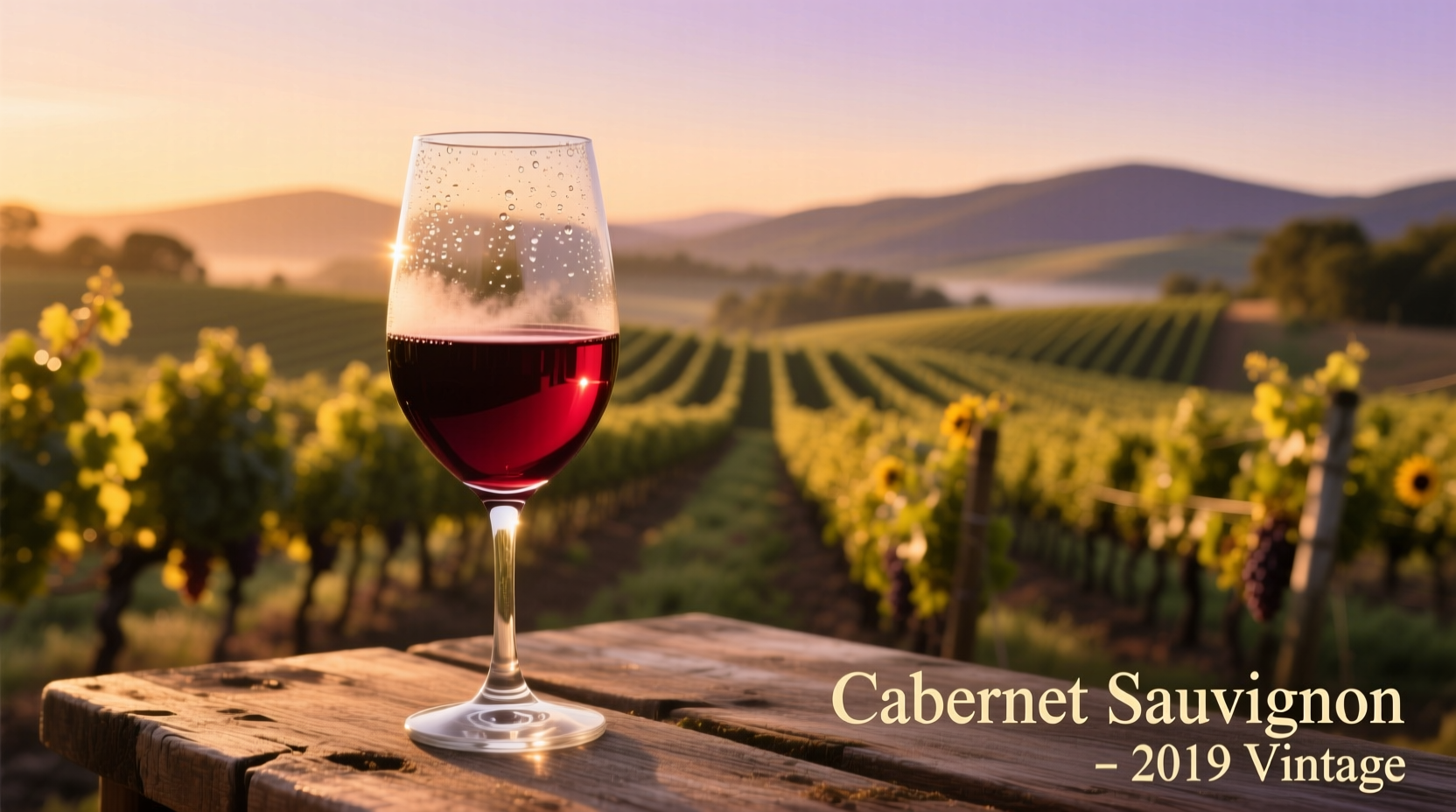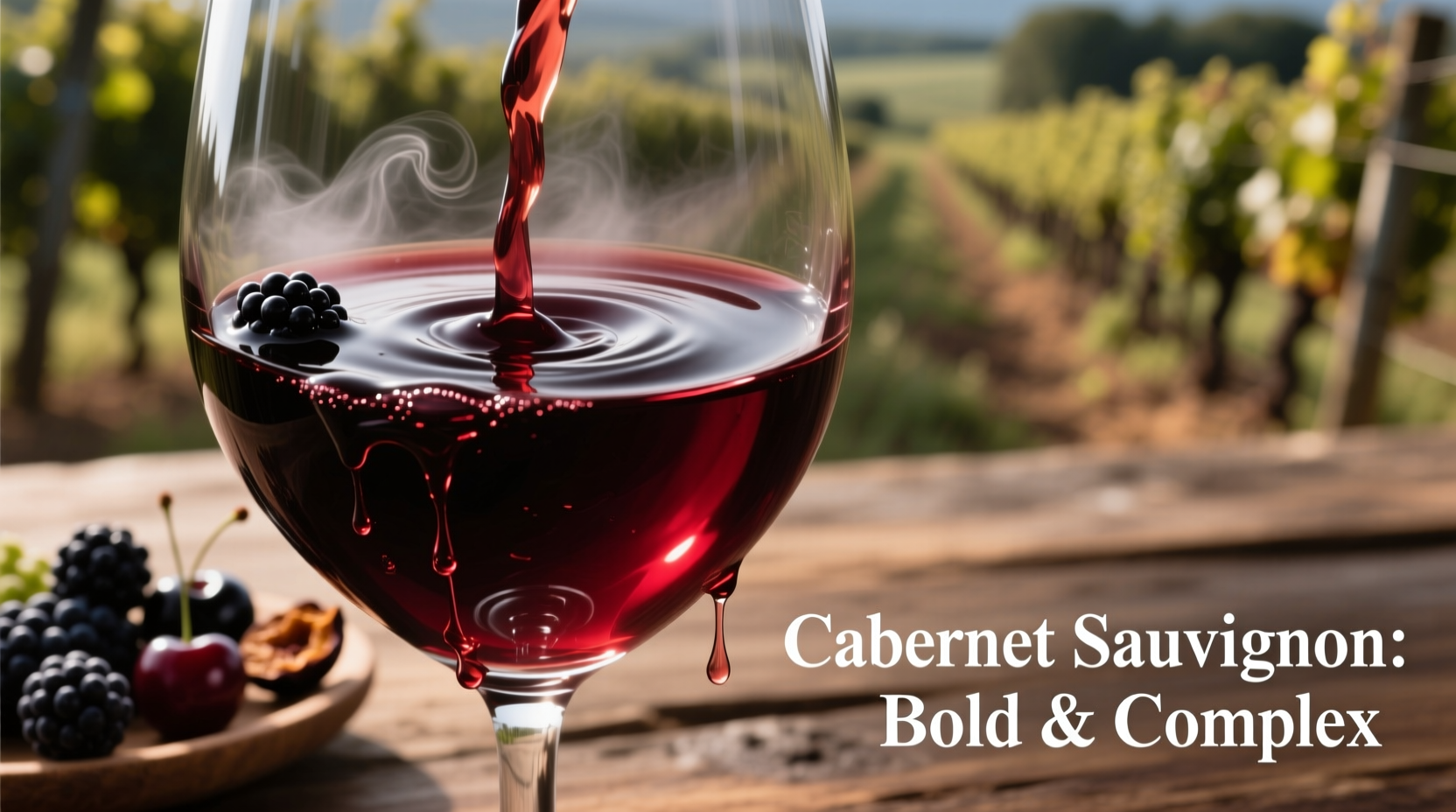Cabernet Sauvignon delivers a robust flavor profile featuring bold dark fruit notes of blackcurrant, black cherry, and plum, coupled with firm tannins, medium-to-high acidity, and distinctive herbal or earthy undertones like green bell pepper, cedar, or tobacco. Oak aging often adds vanilla, spice, and chocolate notes to this full-bodied red wine.
Discover exactly what makes Cabernet Sauvignon one of the world's most beloved red wines. Whether you're selecting your first bottle or refining your palate, understanding Cabernet's distinctive taste profile transforms how you experience this classic varietal. This guide delivers precise tasting insights you can apply immediately—from identifying key flavor components to recognizing regional variations and perfecting food pairings.
The Core Flavor Profile of Cabernet Sauvignon
When you pour a glass of Cabernet Sauvignon, you're experiencing one of the most structured red wines available. The signature taste begins with pronounced dark fruit flavors—primarily blackcurrant (often described as cassis), black cherry, and ripe plum. These fruit notes form the foundation, but Cabernet's complexity comes from additional layers:
- Tannin structure: Firm, grippy mouthfeel that creates that characteristic "drying" sensation
- Acidity level: Medium-to-high acidity providing freshness and balance
- Alcohol content: Typically 13.5-15% ABV contributing to the full-bodied texture
- Secondary notes: Herbal elements like green bell pepper, mint, or eucalyptus (particularly in cooler climates)
- Tertiary characteristics: With aging, develops leather, tobacco, cedar, and earthy mushroom notes
Unlike fruit-forward wines like Pinot Noir, Cabernet Sauvignon maintains structure and complexity that evolves beautifully in the glass. Swirl your glass and notice how the aromas intensify—this wine rewards patience as it opens up over time.
How Regional Differences Shape Cabernet's Taste
Cabernet Sauvignon expresses itself differently based on where it's grown. Understanding these regional variations helps you select bottles matching your taste preferences:
| Region | Climate Influence | Distinctive Flavor Profile | Texture Characteristics |
|---|---|---|---|
| Bordeaux, France | Cool maritime | Blackcurrant, graphite, tobacco, pencil shavings | Firm tannins, structured acidity, elegant finish |
| Napa Valley, USA | Warm continental | Ripe blackberry, cassis, vanilla, baking spices | Softer tannins, plush mouthfeel, longer finish |
| Coonawarra, Australia | Moderate maritime | Mint, eucalyptus, black cherry, earth | Medium body, balanced acidity, distinctive cool-climate profile |
| Maipo Valley, Chile | Warm Mediterranean | Black fruit, chocolate, coffee, subtle herbal notes | Round tannins, approachable texture, fruit-forward expression |
This regional comparison reveals why "Cabernet taste" isn't monolithic. French Bordeaux expressions emphasize earthiness and structure, while Napa Valley versions showcase riper fruit and oak influence. Cooler climate regions like Coonawarra often display distinctive mint or eucalyptus notes—a signature of their terra rossa soil.
The Evolution of Flavor: How Aging Transforms Cabernet
Cabernet Sauvignon uniquely evolves both in the bottle and during your tasting experience. Understanding this timeline helps you appreciate its complexity:
| Stage | Primary Characteristics | Chemical Changes Occurring | Optimal Drinking Window |
|---|---|---|---|
| Youth (0-3 years) | Vibrant dark fruit, pronounced tannins, oak spice notes | Anthocyanins and tannins remain highly reactive | Approachable but tannic; benefits from decanting |
| Development (4-8 years) | Fruit softens, tertiary notes emerge, tannins polymerize | Tannins bind with pigments creating sediment | Ideal drinking window for most premium Cabernets |
| Maturity (9-15+ years) | Leather, tobacco, forest floor dominate, fruit becomes subtle | Complex polymerization completes; volatile acidity may develop | Special occasion drinking; requires careful storage |
According to research from the Oregon State University Enology Program, Cabernet's tannin structure undergoes significant polymerization between years 4-8, creating the smooth mouthfeel associated with well-aged examples. This scientific insight explains why many premium Cabernets require patience before reaching their peak expression.

Practical Tasting Techniques for Cabernet
Maximize your Cabernet experience with these professional tasting techniques:
Temperature Matters
Serve Cabernet between 60-65°F (15-18°C). Too cold suppresses aromas; too warm exaggerates alcohol. Remove from refrigerator 20 minutes before serving if stored chilled.
Glass Selection
Use a large-bowled glass that narrows at the rim—this concentrates aromas while allowing proper aeration. The Riedel Vinum Cabernet glass or similar designs optimize the tasting experience.
Decanting Strategy
Young Cabernets (under 5 years) benefit from 1-2 hours of decanting to soften tannins and release aromas. Mature bottles (over 10 years) require gentler treatment—decant carefully to remove sediment while minimizing excessive aeration that could diminish delicate aged characteristics.
Food Pairing Principles That Work
Cabernet's structure makes it exceptionally food-friendly when matched correctly. Follow these pairing guidelines based on the wine's characteristics:
- Fat content balance: Pair with fatty proteins like ribeye steak or lamb chops—the wine's tannins cut through richness
- Umami enhancement: Mushrooms, aged cheeses, and tomato-based sauces amplify Cabernet's fruit notes
- Avoid delicate dishes: The wine's intensity overwhelms subtle flavors like fish or light poultry
- Salt consideration: Salted foods soften perceived tannins—try with blue cheese or sea-salted meats
Research from the University of California, Davis Department of Viticulture and Enology confirms that the protein and fat in red meat bind with tannins, reducing astringency and creating a smoother mouthfeel. This scientific principle explains why Cabernet and steak form such a classic pairing.
Common Misconceptions About Cabernet Taste
Several myths persist about Cabernet Sauvignon that affect how people perceive its taste:
"All Cabernet is extremely tannic"
While Cabernet has firm tannins compared to lighter reds, modern winemaking techniques and riper fruit harvesting have produced more approachable styles. Many New World Cabernets offer softer tannin structures while maintaining varietal character.
"Cabernet must be expensive to be good"
Quality exists across price points. Regions like Washington State, Chile, and South Africa produce excellent Cabernet Sauvignon in the $15-$25 range that showcases authentic varietal character without excessive oak or alcohol.
"Sweetness indicates quality"
True Cabernet Sauvignon is dry (not sweet). Perceived fruitiness comes from ripe fruit flavors, not residual sugar. If a Cabernet tastes noticeably sweet, it may be blended with other varieties or have added sugar—a practice not typical in quality examples.
When Cabernet Works Best: Context Boundaries
Understanding Cabernet's ideal contexts ensures optimal enjoyment:
- Occasion suitability: Best for substantial meals or contemplative sipping—not ideal as a casual aperitif
- Temperature limitations: Loses complexity when served too warm (>70°F/21°C)
- Food compatibility boundaries: Avoid with spicy foods (amplifies heat) or vinegar-based dishes (clashes with acidity)
- Social context: More appropriate for intimate gatherings than large parties where subtle nuances get lost
Recognizing these context boundaries prevents disappointing experiences. For instance, Cabernet's intensity makes it less suitable for outdoor summer picnics compared to lighter reds, but it shines during cooler months with hearty meals.
Developing Your Cabernet Palate
Refine your ability to identify Cabernet's distinctive characteristics through these practical exercises:
- Blind tasting practice: Compare Cabernet against similar varieties (Merlot, Malbec) to isolate its blackcurrant signature
- Aroma identification: Use a wine aroma kit to train your nose to recognize cassis, tobacco, and cedar notes
- Vertical tasting: Sample the same producer's Cabernet across multiple vintages to understand aging progression
- Food pairing experiments: Try the same Cabernet with different preparations of steak (grilled, pan-seared, roasted) to observe flavor interactions
Professional tasters at the Institute of Masters of Wine emphasize that consistent practice with focused attention builds palate memory more effectively than occasional tasting. Dedicate just 15 minutes weekly to structured tasting exercises to noticeably improve your Cabernet appreciation within months.
Frequently Asked Questions
Is Cabernet Sauvignon sweet or dry?
Cabernet Sauvignon is a dry red wine with minimal residual sugar (typically under 1g/L). Its ripe dark fruit flavors like blackberry and black cherry may create a perception of sweetness, but technically it's dry. The high tannin structure further emphasizes its dry character rather than sweetness.
Why does Cabernet taste like blackcurrant?
Cabernet Sauvignon contains pyrazines and specific esters that create a distinctive blackcurrant (cassis) flavor profile. This characteristic comes from the grape's genetic makeup, particularly prominent in Bordeaux varieties. Cooler climate expressions often show more pronounced green bell pepper notes alongside the cassis, while warmer regions produce riper black fruit expressions.
How does oak aging affect Cabernet's taste?
Oak aging significantly shapes Cabernet's flavor profile. New French oak imparts subtle cedar, tobacco, and spice notes, while American oak contributes stronger vanilla, coconut, and dill characteristics. The toast level of the barrel (light, medium, heavy) determines whether you'll taste baking spices, caramel, or roasted coffee notes. Extended oak contact (18-24 months) integrates these elements with the wine's natural fruit profile.
What's the difference between Cabernet Sauvignon and Merlot taste?
Cabernet Sauvignon features more pronounced blackcurrant notes, firmer tannins, and higher acidity than Merlot. Merlot shows riper plum and black cherry flavors with softer tannins and a rounder mouthfeel. Cabernet's herbal notes (like green bell pepper) are more prominent, while Merlot often displays chocolate and mocha characteristics. In cooler vintages, Cabernet's pyrazine expression creates distinctive vegetal notes not found in Merlot.
Why does some Cabernet taste like green bell pepper?
The green bell pepper flavor in Cabernet comes from methoxypyrazines, compounds naturally present in the grape skins. Cooler climate regions (like Bordeaux or Coonawarra) and earlier harvests preserve more of these compounds. As grapes ripen fully, pyrazine levels decrease, which is why warmer regions like Napa Valley produce Cabernets with riper fruit profiles and less pronounced green notes. This characteristic is considered a signature element of classic Cabernet expression.











 浙公网安备
33010002000092号
浙公网安备
33010002000092号 浙B2-20120091-4
浙B2-20120091-4